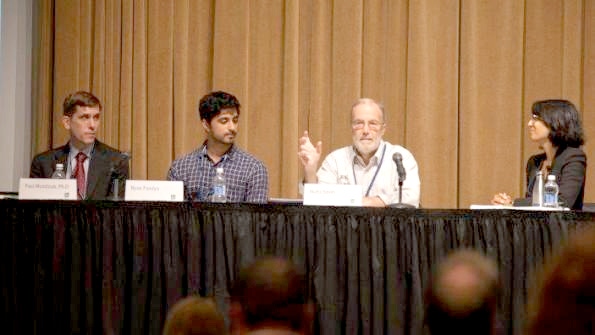
The focus of agriculture is plants and animals, but scientists are looking to “cellular agriculture” as a means to produce food from cell culture as one more way to feed a growing world population.
“The reason we want to investigate this new facet of agriculture is because we believe that if by growing foods directly from cells instead of full plants and animals then we can achieve even more efficiencies when it comes to environmental resources and avoid the public health issues that come from raising whole plants and animals,” explained Isha Datar, president and executive officer of New Harvest, a non-profit research agency, based in New York and launched in 2004 to establish the field of cellular agriculture.
Datar was part of a panel discussion on cellular agriculture at the North Carolina Biotechnology Center’s Ag Biotech Summit held Sept. 27 at the William and Ida Friday Center at the University of North Carolina, Chapel Hill. Datar and other speakers emphasized that cellular agriculture is clearly in its infancy with few groups working in the field, but they believe the new technology holds great promise and potential.
One of the projects New Harvest is funding is research led by Paul Mozdiak, professor of poultry science at North Carolina State University, to create turkey cells for the production of turkey meat. At the summit, Mozdiak explained he is looking at ways to scale up the production of producing meat through in vitro methods.
“We really are at the infancy of what we are doing in my laboratory, but things are now starting to move along in this arena,” Mozdiak said. “I know many are skeptical about this technology, and frankly I have been thinking about it for the past 20 to 25 years. There just hasn’t been impetus to really work on it because there has been a challenge in garnering research support. The message that I have is that it’s not going to happen today, it’s not going to happen yesterday, it’s not going to happen tomorrow, but it’s going to happen.”
New Harvest is also supporting the work of Perfect Day, a startup company in Berkley, Calif., that is working to make milk, yogurt and cheese from genetically engineered yeast and plants that can be modified to leave out cholesterol, hormones and lactose found in natural dairy products. “We can make all of your favorite dairy products. We don’t need any animals,” said Ryan Pandya, co-founder and chief executive officer of Perfect Day.
Perfect Day does not currently have any products on the market, but Pandya expects Perfect Day to release its first cellular dairy product by the end of next year. He sees great potential because of strong consumer demand for such products as non-dairy soy milk and almond milk. He believes consumers who buy non-dairy milk would jump at the chance to buy non-dairy cheese and yogurt.
“We are doing this in a way that is realistic, deliberate and efficient and that’s possible for us in part because we are making dairy products not steak,” he said. “I think the challenge for the industry is to figure out ways to make more complicated products, and one of the things I hope to do at Perfect Day is normalize the general field for the public and make it seem like this is milk, this is yogurt, this is cheese; it was made without animals.”
At the summit, Datar, Mozdiak and Pandya all emphasized that cellular agriculture will never replace plant and animal agriculture. They view cellular agriculture as another means to feed a growing world population.
“People want choices. Part of the choice is they want animal products without animals,” Mozdiak said.
Mozdiak sees cellular agriculture as a niche biotechnology market that won’t significantly impact animal agriculture for the next five to 10 years. “The question is where are we going to be 50 years from now as the processes that are just being developed today become reality. Will we be able to produce meat on a smaller land mass, be able to produce it cheaper, better and faster? I think those are the questions that need to be answered in the next five to 10 years,” he said.
Mozdiak made it clear that cellular agriculture is now at “ground zero” and the technology is in its infancy. In addition, finding research funding is a challenge “We have some proof of concept, but there are really no production systems in place as it stands right now,” he said.
Pandya agreed that the technology is “not here yet and maybe now way near here yet, but it is coming.” He said cellular agriculture is both possible and inevitable. It is beginning with dairy and Pandya believes it will be possible with meat as well.
“We’re not trying to replace anything. We’re trying to create another compelling option for people that are looking for it. And people are looking for it, they just can’t find it yet,” he said.
Hultz Smith, principal scientist at Tysons Foods, said Tysons doesn’t consider the concept of cellular agriculture as a competitor but as another potential source to feed the world. Still, Smith urges proponents of cellular agriculture to be careful with their message because many people don’t understand the sciene. He said they have a great task ahead of educating the public.
“You have to explain it to them because all they see is voodoo,” he said, pointing to the challenges agriculture has faced with genetically modified organisms which said offer great benefits in feeding the world but have been condemned by people who don’t understand the science.
“This can’t be another GMO,” he stressed. “Consumer perception rules in the retail marketplace. That’s what you folks are battling.”
About the Author(s)
You May Also Like






